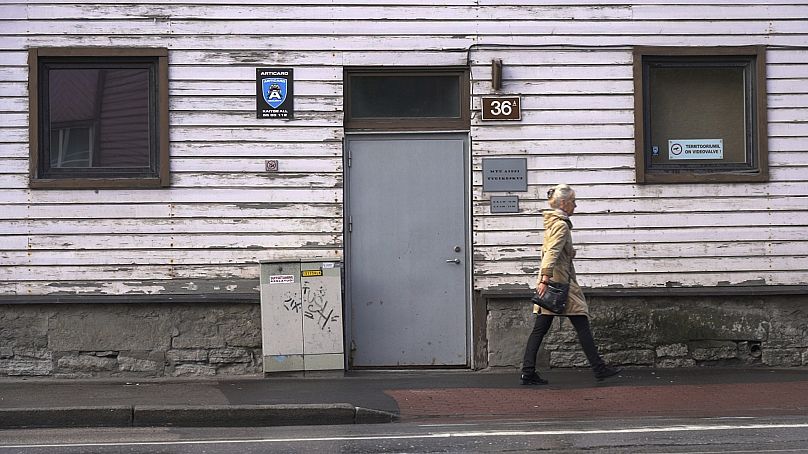While fentanyl continues ravaging the US, the European illegal drug market has remained somehow shielded from the deadly synthetic opioid. Is that about to change?
In San Francisco’s Tenderloin, the downtown neighbourhood infamously known for its rampant homelessness, crime, and drug abuse, fentanyl users are scattered along the streets, their numb bodies abandoned in unlikely positions on park benches and sidewalks.
These are the scenes that Gen-Z activist Darren Stallcup, who has lived in the Tenderloin all his life, regularly records with his phone camera and then shares with the world on Twitter.
Fentanyl, a powerful synthetic opioid, is killing Americans - and San Francisco residents - at an alarming rate. Between January and March of 2023, 200 people died of overdose in the Tenderloin, with 159 deaths being caused by fentanyl - more than during the same time frame the year before. On a national level, the number of Americans dying of drug overdose has risen from more than 70,000 in 2019 to over 100,000 in 2021. Most of these deaths are due to fentanyl.
Stallcup told Euronews that he has seen so many people dying of an overdose in the streets of his neighbourhood that he feels “absolutely traumatised.”
When the 25-year-old activist travelled to London for a holiday recently, he said he felt refreshed. Nobody was dying of fentanyl in the streets of the European capital, nobody was using the drug in plain sight. “The most important thing,” Stallcup said, “is to make sure fentanyl doesn’t find its way into the UK, and Europe.”
But fentanyl has already been found to circulate in Europe - even though it often slips in under false pretences.
In December 2016, an 18-year-old boy died after buying what he thought was a pill of morphine at a fun fair in Cannes. He died of overdose later that same evening after consuming the pill which contained fentanyl - a few milligrams of which can be lethal. Fentanyl is similar to morphine, but it’s 50 to 100 times more potent.
Fentanyl kills in Europe too - but much less than in the US
Similar tragedies as that of the 18-year-old in Cannes are common in the US, where the powerful synthetic opioid painkiller has killed tens of thousands of Americans in the last few years, becoming the most lethal drug in the history of the country. But they’re unusual in Europe, a continent which has remained widely shielded from the spread of the killer drug.
There were an estimated 5,800 overdose deaths in the EU in 2020, according to the European Monitoring Centre for Drugs and Drug Addiction (EMCDDA) - an underestimate, EMCDDA’s Scientific Director Paul Griffiths told Euronews. Opioids were present in three-quarters of all these deaths, while fentanyl accounted for “probably a couple of hundreds,” Griffiths said.
By comparison, in the same year, the US reported 53,480 fentanyl-induced deaths.
In the US, fentanyl used to be available under prescription as a painkiller. Thousands of people got addicted to it after having been prescribed the drug by their doctors since the 1990s.
Once the country’s authorities realised the gravity of the situation, it was already too late. Though pharmaceutical companies stopped producing and selling fentanyl, the production of the drug and its supply has been taken over by criminal gangs, with manufacturing reportedly taking place illegally in countries like China and Mexico.
Because of how easy it is to produce it, fentanyl is often laced by drug dealers with other drugs like heroin, cocaine, methamphetamine, and MDMA. That means that often drug users end up consuming fentanyl without knowing they’re doing so.
According to a recent analysis by the Washington Post, fentanyl is the leading cause of death for Americans aged 18 to 49.
A fentanyl epidemic in Estonia
Europe has a precedent with fentanyl that long precedes the incident involving 18-year-old Joseph in Cannes in 2016.
Back in the early 2000s, Estonia experienced a shortage of heroin which led to a sudden rise in fentanyl use, with the synthetic drug quickly becoming the most used opioid among drug addicts.
For almost two decades the Baltic country battled a fentanyl epidemic, until police choked off supply in 2017 by shutting down a clandestine laboratory, and fentanyl finally seemed to disappear from Estonia.
But fentanyl left a trail of death in the country. According to figures estimated by the EMCDDA, some 1,600 people have died of overdose in the Baltic state between 2001 and 2020, the majority of which due to the use of fentanyl and other synthetic opioids.
A Taliban-made opioid shortage is looming over Europe
The story of Estonia’s very own fentanyl epidemic should be a warning for the present - especially as a shortage of opioids could soon hit the continent. In Afghanistan, where most of Europe’s heroin supply comes from, the Taliban imposed a ban on poppy cultivation in April 2022 whose impact is likely to be felt in the continent next year, as last year’s harvest was exempt from the ban.
Almost all opium in Afghanistan is harvested between April and July, and it takes about one to one and a half years from harvest to heroin markets, according to 2022 estimates by the United Nations Office on Drugs and Crime (UNODC).
The sudden lack of opioids might open up an opportunity for criminals to manufacture and sell synthetic drugs like fentanyl, which is far more profitable than heroin. According to the US Drug Enforcement Administration, one kilogram of fentanyl bought in China for a sum between $3,000 and $5,000 (between €2,768 and €4.613) can be resold for more than $1.5 million €1.38 million). Because of its potency, which is 30 times more than that of heroin, fentanyl could quickly replace other drugs and take over the European local drug scene.
“It will be interesting to see what happens with the reported Taliban’s ban and whether that actually has a long-term impact,” Griffiths said. “At the moment what we've seen looks like a very, very slight contraction in the area of poppy cultivation, but it’s still quite high by historical standards. A little less is being produced compared to now, and we would expect at least a year - because of the existence of stocks, because of the time it takes to bring the drugs to market - to have an impact on the drug market in Europe.”
But Griffiths is sceptical of the ban, saying that it’s more likely that the move is aimed at manipulating the price of opioids by reducing their availability on the market.
Could fentanyl take over Europe?
While there’s no current market for fentanyl in Europe, the risk that the drug might eventually take over in Europe is real, and it’s been recognised by the European Union Agency for Law Enforcement Cooperation (Europol), the EU's law enforcement agency assisting law enforcement authorities in EU member countries.
In a recent report, Europol writes that the same Mexican drug cartels which are flooding the US illicit drug market with fentanyl are cooperating with EU-based criminal networks to traffick and smuggle cocaine and methamphetamine in Europe. The agency warns that these Mexican criminal groups might “attempt to broaden the portfolio of drugs trafficked to the EU by either trafficking them to the EU drug market or by assisting in the production of those drugs, like fentanyl, in the EU.”
“Despite no current indications of a fentanyl market in the EU, the discovery of fentanyl production facilities and seizures of the substance in the EU raises concerns over the development of a fentanyl market,” the agency writes.
On its side in the battle against fentanyl, Europe has time, Griffiths said - as well as a completely different attitude towards medicinal drugs and painkillers. “We don’t have the same dynamics as most in terms of attitude to painkiller prescribing, and we tend to have treatment available for people with lifelong conditions,” Griffiths said.
Prescription opioids are rarely given to patients in Europe, though consumption of prescribed fentanyl has grown from 1.66 to 2.77 DDD/1000 inhabitants/day in Spain between 2010 and 2021, according to the Spanish medicine agency.
The illegal drug market is also different in Europe. “The ground [in the US] was prepared for the illicit drug market, and then you had some Mexican drug trafficking organisations getting into fentanyl production because of the advantages linked to it,” Griffiths said.
But this doesn’t mean we should be complacent. “There might in the future be the possibility of seeing more synthetic opioids in the European illicit drug markets,” Griffiths said. Synthetic opioids like fentanyl are easy to produce and they’re highly profitable.
“There are lots of reasons why these might be attractive to organised crime groups and gangs if there was a sufficient market, if the market dynamics changed,” Griffiths concluded.


















